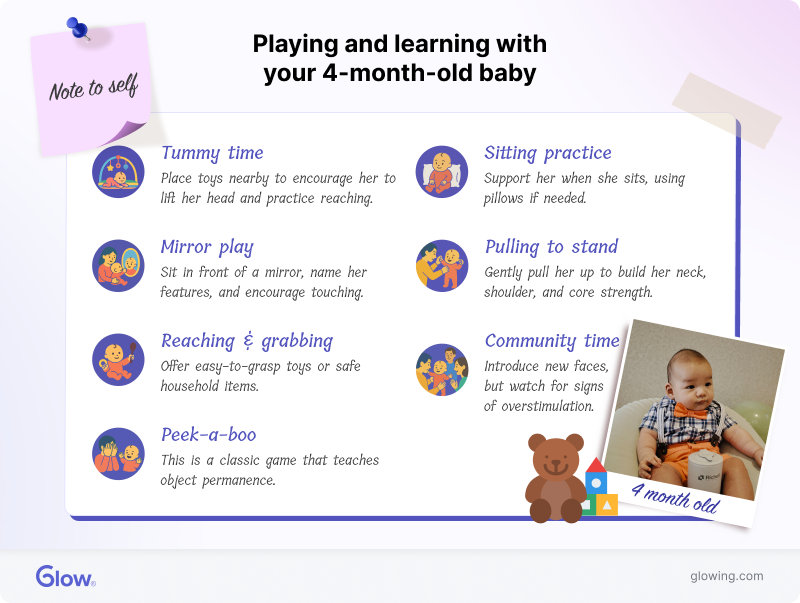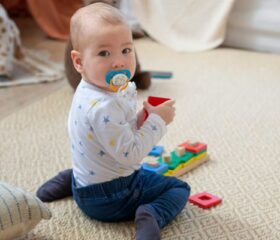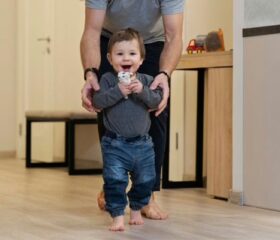Baby Month by Month
4-Month-Old Baby
Your baby can recognize herself in the mirror.

Your little one is growing into an active, curious infant. Get ready for lots of smiles, coos, and mini-adventures as your baby develops physically and starts really exploring the world.
Read on to learn how to keep up with her growth and make sure she stays happy, healthy, and safe.
Your baby’s development at 4 months
Your baby is making big strides in her development. From her newfound strength to creating her own adorable baby language, here’s what’s happening with your tyke.
Your baby’s physical development
Your baby has more control over her body and is building the strength and coordination she needs to meet future physical milestones:
- Head control: Your baby may now be able to hold her head steady for longer stretches at a time. 1
- Tummy time mastery: As she develops the strength to lift her head and chest, she may push onto her elbows in a “mini push-up”—think of a cobra pose in yoga with her legs extended behind.
- Rolling over: She may or may not be rolling over yet, but when she does, it’ll likely be from tummy to back first. 2
- Grasping and reaching: Someone can’t resist the allure of all things shiny. Your baby may reach for objects like necklaces, earrings, or anything else that catches her eye. Watch out; everything she grabs could also be fair game for trying to eat, too!
- Foot fascination: Even your baby loves those cute little feet of hers. Playtime could mean grabbing, playing with, or even mouthing her feet.
- Leg strength: When you hold her upright, she can bear some weight on her legs. Continue giving her full support so she doesn’t hurt herself.
Your baby’s cognitive and social development
In addition to her physical changes, your baby’s cognitive and social skills are also emerging:
- Facial expressions: Her range of facial expressions has expanded—get your camera ready for genuine smiles and giggles.
- Object recognition: She’ll start recognizing people, pets, and toys and may even start reaching out to them. 3 She’ll probably prefer familiar faces like mom, dad, and her siblings.
- Communication skills: This month is around the time when babies start babbling, which may involve making consonant sounds paired with vowels like “ga-ga” or “ba-ba,” and eventually “mama” or “dada.”
- Exploring through play: Playtime is more intentional now as she grabs, pushes, kicks, and turns her body.
- Frustration with interrupted play: Now that your baby knows what playtime is, don’t be surprised if she cries or gets frustrated when you stop it or take her favorite toys away.
Your baby’s sensory development
Your baby’s senses are also becoming more refined this month:
- Improved vision: Her distance vision is improving. She can recognize objects that are further away and track moving objects. 4
- Self-discovery: She can recognize herself in a mirror, watching her own movements and expressions.
- Mimicking and imitation: She’s probably starting to mimic your sounds and facial expressions when you interact with her. 5
- Communication: Her hearing is more attuned to the nuances of language. Her cries may now sound different depending on what she needs. 6
- Sensitivity to tone of voice: She’s more aware of what different sounds indicate—gentle voices soothe her, while harsher tones indicate there’s a problem.
How to create a safe environment for your 4-month-old
Your baby is growing more curious every day. While it’s great for her development, she’s also more at risk of encountering hazards. Here’s how to keep your baby safe:
- Babyproofing: As your baby gets more mobile, make sure you extensively baby-proof your home. You’ll need baby gates for staircases, furniture anchors, light socket covers, cabinet locks, and more. 7
- Clean hands: Wash your hands frequently, especially after using the bathroom, changing diapers, returning from outside, and before eating. Make sure that family members also do this to help prevent the spread of germs.
- Plants: Keep houseplants out of reach so that your little one doesn’t try to grab them and eat the leaves.
- No phones: Don’t let your baby play with your phone, as screen time isn’t recommended before age 2. 8

Playing and learning with your baby
Who doesn’t love playtime? This isn’t just about having fun with your little one—it’s essential for her development. Your bond strengthens through play, and she’ll learn more about the world by playing with you.
Try these activities with your baby this month:
- Tummy time: Place toys near your baby to encourage her to lift her head and reach out while lying on her tummy. A colorful play mat with hanging toys can make this more engaging.
- Mirror play: Sit with your baby on your lap in front of a mirror. Point to and name her features—nose, ears, eyes. Encourage touching the mirror to build her self-awareness.
- Reaching and grabbing: Offer toys that are easy to grasp. Everyday household objects (think wooden spoons or plastic cups) are also perfect for fine motor skill practice.
- Peek-a-boo: Some stereotypes do ring true—babies love peek-a-boo. This timeless game teaches object permanence (the idea that things continue to exist even when they’re hidden).
- Sitting practice: Once she’s capable of holding her head steady, help her sit up for short periods on your lap or use pillows to prop her up. She may slump or slip initially, but her coordination will improve over time.
- Pulling to stand: If you gently pull your baby up by her arms, she may lift her head and shoulders. This will help her build the neck, shoulder, and core strength she’ll need for sitting and, eventually, standing.
- Community time: Introduce your baby to others to help her adjust to new faces and sounds. Watch for signs of overstimulation, like fussiness, and take breaks whenever she needs them.
Be sure to closely supervise your child while she plays, especially if any of her toys are small enough that they could be choking hazards (although hopefully, they’re all designed to be as safe as can be).
Encouraging baby talk
Language development begins early. Encourage your baby to speak as much as possible to build her communication skills. 6
Narrate your daily activities, such as making meals or folding laundry, to familiarize her with speech rhythms and sounds. Point out objects and sounds while naming them. Say, “That’s the dog barking,” or “There’s your blue rattle.”
Make eye contact when your baby coos or babbles, and respond enthusiastically to boost her confidence. When your baby makes a sound, repeat it back to her, adding a word to the end. (For instance, if she makes the “ba” sound, you can turn that into “ball!”)
It’s never too early to start reading to your child
Reading to your baby is another great way of encouraging her to develop her language skills. Use sturdy board books, children’s picture books, or read aloud from a magazine or novel. The content is less important than the act of reading together.
Feeding your 4-month-old
At 4 months old, your baby’s primary source of nourishment should still be breast milk or formula. The American Academy of Pediatrics (AAP) recommends exclusive breastfeeding until your baby is 6 months old, and even after she starts on solid foods, milk should still be her main food source until she’s 12 months old. 9
You may notice that her eating patterns start changing this month. Your baby might go longer between feedings, up to 4 to 5 hours, but consume more each time. 10
If you’re bottle feeding, she’ll drink 4 to 6 ounces per feeding, about five times a day. 11 Breastfeeding or pumping moms can expect to produce 24 to 32 ounces of milk daily by 4 months old. 12
Watch for your baby’s cues that she’s hungry—licking her lips, sticking out her tongue, fussing, or sucking on her knuckles.
Can babies have solid food yet?
While some babies start to show readiness for solids between 4 and 6 months, it’s still quite early for that. Again, your baby is getting all the nutrition she needs from breast milk or formula, so it’s best to wait for solids unless your doctor gives you the OK to do otherwise. 3
With that said, signs that your baby may be ready for solid food include: 13
- Sitting upright with good head control
- Interest in food
- Grabbing objects and bringing them toward her mouth
- Swallowing food without pushing it out with her tongue (although doing this early on in the process of transitioning to solids is also normal)
Take cues from your baby, but know that introducing solids too early could increase her risk of developing allergies or digestive issues. 3
Your baby’s sleep at 4 months
Your baby still sleeps a lot, about 14–16 hours in total each day. You might see some changes in her sleep patterns, such as: 3
- Longer stretches: At this age, many babies start sleeping through the night for 6 to 8 hours at a stretch. 14
- Naps: She’ll still take 2–3 naps daily, each lasting 1–2 hours. 14 Babies this age can usually go 2–4 hours between naps, so keep following her sleep cues.
Some babies do well with one morning nap, one afternoon nap, and an earlier bedtime, while others prefer a late afternoon nap and a later bedtime.
Sleep regression: navigating the ups and downs
Sleep disruptions are common at four months, usually coinciding with significant developmental milestones like developing the ability to roll over. 5 This is often known as sleep regression, and it’s a normal part of your little one’s development. Signs that she’s going through sleep regression include:
- Waking up more frequently at night
- Having trouble falling or staying asleep
- Refusing to take naps
- Taking shorter naps
Don’t let sleep regression get you down—sleep setbacks are temporary. Just be patient.
Bedtime routines for four-month-olds
Sometimes, it might seem like your baby would rather do anything other than sleep. Setting a bedtime routine will help “calibrate” her sleep schedule and let her know when it’s time to get some shut-eye. 15
Start her routine around the same time every night to regulate her internal clock. You can also get her ready for bed by:
- Creating a calm environment (e.g., dim the lights and turn off screens)
- Giving her a warm bath and a gentle massage (but don’t bathe your newborn too often—no more than three times a week in her first year)
- Reading a book or singing a lullaby
- Feeding her one last time before bed
- Saying goodnight
Sleep training at four months
Some babies naturally fall into a rhythm, while others need help. Sleep training isn’t a must, but it can be helpful if your baby’s struggling with sleep and you’re not getting proper rest.
If you decide to try sleep training, remember there’s no one-size-fits-all approach—methods range from gentle, gradual techniques to more structured and controversial ones, like the infamous cry-it-out method. 16
Your baby’s health at 4 months
As well as feeding, playing, and changing all those diapers, you’ll also have to make sure your baby is healthy.
The 4-month well visit
Your baby’s 4-month well visit is an opportunity to check in on her growth and development, ask questions, and get her vaccinated.
Your baby’s weight, height, and head circumference will be measured and plotted on a growth chart. By this time, most babies will have doubled their birth weight. 3 The average length for girls at 4 months is 22–26.5 inches; boys tend to be 23–27 inches. 17
Her 4-month well visit will also involve:
- Developmental assessment: Your doctor will check for developmental milestones like rolling and reaching to confirm that she’s engaging with her surroundings as expected.
- Physical examination: They’ll also ensure she’s healthy from head to toe, checking her eyes, ears, heart, lungs, and reflexes.
- Guidance: Most pediatricians will use this as an opportunity to bring you up to speed on car seats, babyproofing, safe sleep practices, and more.
Come armed with questions for your doctor. This is a great chance to ask about your baby’s sleep, feeding, or development. Now’s also a good time to bring up any persistent skin issues your baby has been dealing with, such as baby acne, rashes, eczema, or flakes on her scalp (cradle cap). All of these are common at this stage, but they’re also very treatable.
Vaccinations at four months
Like we just alluded to, the 4-month visit is a good time to get your baby vaccinated, which is important to protect her from serious illness. Here’s a look at key vaccines (and other immunizations) and what they protect against:
- Rotavirus vaccine: This oral vaccine protects your baby against rotavirus, which can cause stomach bugs that could lead to dehydration. 18
- Pneumococcal conjugate vaccine (PCV): Given via injection, this protects your baby from bacteria that could cause ear infections, pneumonia, blood infections, and meningitis. 19
- Inactivated polio vaccine (IPV): The second dose of the polio vaccine is an injection to shield your baby from the highly contagious polio virus, which can cause paralysis and life-threatening complications. 20
- DTaP vaccine: This combination shot protects her from three diseases: diphtheria, a bacterial infection that can lead to difficulty breathing, heart failure, or paralysis; tetanus, a bacterial infection that can also cause paralysis (known as “lockjaw”); and pertussis, an infection commonly known as whooping cough. 21
- Hib vaccine: The Haemophilus influenzae type b (Hib) vaccine protects her from bacterial infections that can lead to meningitis, pneumonia, and bloodstream infections. 22
- RSV antibody: Lastly, this immunization (which technically isn’t a vaccine) protects your little one from respiratory syncytial virus (RSV), a common virus that can lead to severe respiratory infections in babies, including bronchiolitis and pneumonia. Your pediatrician may recommend administering this treatment during your baby’s first RSV season, between October and March. 23
Always consult with your pediatrician if you have any questions or concerns about your baby’s immunization schedule.
Common illnesses at four months
Even if you stay up-to-date with your baby’s vaccines and keep her clean, it’s only natural for her to get sick from time to time. Be aware of the following illnesses and learn the signs that it’s time to call your doctor.
Colds
Colds are common, especially for infants who have older siblings or who are around other babies. You may notice a runny or stuffy nose, sneezing, mild fever, coughing, watery eyes, and decreased appetite. 24 Most colds are mild, but contact your doctor if you notice:
- A cough lasting more than a week.
- Difficulty breathing or wheezing.
- Bluish lips or fingernails, which indicates a lack of oxygen.
Bronchiolitis
Caused by viruses like RSV, bronchiolitis is inflammation in the lungs’ small airways. Symptoms include wheezing, rapid breathing, persistent coughing, and trouble feeding. Seek immediate medical care if your baby:
- Has visible difficulty breathing (e.g., flaring nostrils, grunting, chest retractions).
- Shows signs of dehydration, including fewer wet diapers.
Fever
If your baby has a temperature of 100.4°F (38°C) or higher, she’s got a fever, so you’ll need to contact your pediatrician. 25 It’s especially urgent to let them know if her temperature is 102°F (38.9°C) or higher or if your baby is:
- Unusually fussy
- Lethargic
- Has a rash
- Has trouble breathing
While you can use various digital thermometers to check her temperature, a digital rectal thermometer is the most accurate tool for this. To correctly use one, follow these steps:
- Apply a small amount of petroleum jelly to the tip.
- Gently insert the thermometer no more than 1/2 to 1 inch into your baby’s rectum while holding her legs steady.
- Wait for the thermometer to beep and note the reading.
Remember to always clean the thermometer thoroughly before and after use.
Looking after yourself with a 4-month-old baby
With your life revolving around your child’s well-being, you may have forgotten that you need to look after yourself, too.
It’s OK to look for support when you need it. Reach out to your partner, friends, or family members and. ask them for help with feeding, bathtime, and bedtime. Not only will this give you a much-needed break, but it’ll also help your baby connect with more people, which is great for her socialization.
Stay in regular contact with your own doctor during your first year after giving birth so they can address any lingering physical or emotional concerns.
Be aware of postpartum depression
Many women suffer from the baby blues not long after they give birth. Some women even feel intense anger or irritability during this period (postpartum rage). While these feelings are normal and usually not serious or long-lasting, if you still feel consistently cranky, sad, or overwhelmed after 4 months, you may have postpartum depression.
Postpartum depression is common in new moms and can last months or even years after giving birth. If you’re struggling with your mental health, speak with your doctor or therapist.
Final thoughts
As your baby starts rolling, babbling, and grasping her way into her 4th month, you’ll see more of her adorable personality coming through.
Being a mom is no easy task, so make sure you get some rest and don’t feel shy asking your loved ones for support. But above all, celebrate! Your little bundle of joy is getting less little by the minute, so enjoy these special moments with her while they last.
Article Sources
- MyHealth.Alberta.ca. "Sensory and Motor Development, Ages 1 to 12 Months" Retrieved July 17, 2025.
- Help Me Grow Minnesota. "Baby Milestones – When Babies Sit Up, Roll Over and Crawl" Retrieved July 17, 2025.
- MedlinePlus. "Developmental milestones record - 4 months" Retrieved July 17, 2025.
- MedlinePlus. "Infant - newborn development" Retrieved July 17, 2025.
- U.S. Centers for Disease Control and Prevention. "Important Milestones: Your Baby By Four Months" Retrieved July 17, 2025.
- The National Institute on Deafness and Other Communication Disorders. "Speech and Language Developmental Milestones" Retrieved July 17, 2025.
- U.S. Consumer Product Safety Commission. "Childproofing Your Home - Several Safety Devices to Help Protect Your Children from Home Hazards" Retrieved July 17, 2025.
- MedlinePlus. "Screen time and children" Retrieved July 17, 2025.
- American Academy of Pediatrics. "Newborn and Infant Breastfeeding" Retrieved July 17, 2025.
- WIC Colorado. "Infant Feeding Guide" Retrieved July 17, 2025.
- Food and Nutrition Service. "CACFP Infant Meal Pattern" Retrieved July 17, 2025.
- Office on Women's Health. "Common breastfeeding challenges" Retrieved July 17, 2025.
- Penn Medicine. "News and views" Retrieved July 17, 2025.
- MedlinePlus. "Bedtime habits for infants and children" Retrieved July 17, 2025.
- American Academy of Pediatrics. "Getting Your Baby to Sleep" Retrieved July 17, 2025.
- American Academy of Pediatrics. "Self-Soothing: Help Your Baby Learn This Life Skill" Retrieved July 17, 2025.
- U.S. Centers for Disease Control and Prevention. "WHO Growth Charts—Download" Retrieved July 17, 2025.
- MedlinePlus. "Rotavirus vaccine - what you need to know" Retrieved July 17, 2025.
- MedlinePlus. "Pneumococcal conjugate vaccine - what you need to know" Retrieved July 17, 2025.
- MedlinePlus. "Polio vaccine - what you need to know" Retrieved July 17, 2025.
- MedlinePlus. "DTaP (diphtheria, tetanus, and pertussis) vaccine - what you need to know" Retrieved July 17, 2025.
- MedlinePlus. "Haemophilus influenzae type b (Hib) vaccine - what you need to know" Retrieved July 17, 2025.
- U.S. Centers for Disease Control and Prevention. "RSV Immunization Guidance for Infants and Young Children" Retrieved July 17, 2025.
- Paediatrics & Child Health. "Colds in children" Retrieved July 17, 2025.
- MedlinePlus. "When your baby or infant has a fever" Retrieved July 17, 2025.







